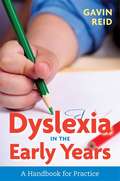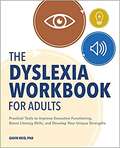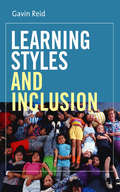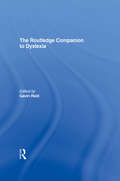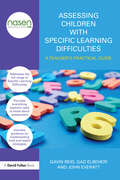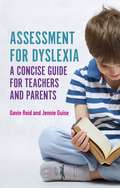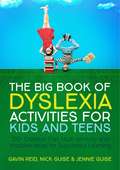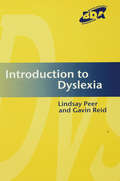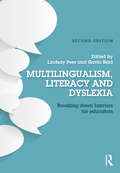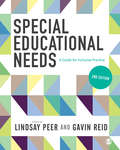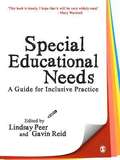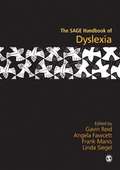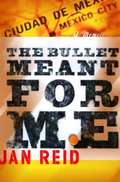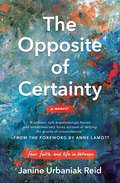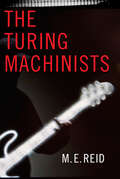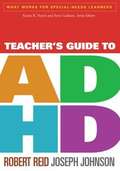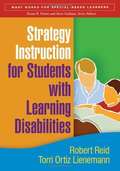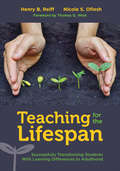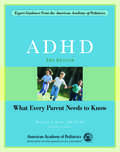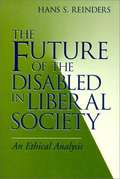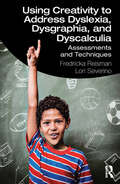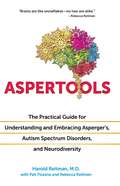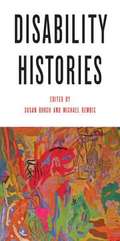- Table View
- List View
Dyslexia in the Early Years: A Handbook for Practice
by Gavin ReidResearch has shown that early identification and intervention is crucial and can in fact minimise, and may even prevent, the challenges of dyslexia from becoming too detrimental at later stages of education. This book offers both research insights and practical guidance for teachers working in Early Years settings on how to create resource materials that would be suitable for the development of children with dyslexia. Beginning with a contextual note on the key difficulties faced by children at risk of dyslexia, the book takes the reader through the processes of identification and diagnosis, before offering ideas on how to tailor classroom materials for these students. The book's resource materials are designed to target areas such as reading, spelling, numeracy, language skills, social and emotional development, and problem solving skills.
The Dyslexia Workbook for Adults: Practical Tools to Improve Executive Functioning, Boost Literacy Skills, and Develop Your Unique Strengths
by Gavin ReidImprove your skills and discover the strengths of your dyslexia―strategies and exercises for adults <P><P> Dyslexia is a continuous, lifelong journey―one that asks you to adapt and grow every day. The Dyslexia Workbook for Adults offers practical tools, techniques, and activities to help you improve your literacy skills, boost your self-esteem, and use your dyslexia as an advantage. <P><P> Gain a sense of empowerment and a greater appreciation for the positive aspects of dyslexia with exercises designed to develop the strengths unique to dyslexic patterns of thinking. Explore specific strategies for targeting problems that adults with dyslexia experience with spelling, reading, writing, memorization, organization, and other executive functioning skills. You’ll come to see your dyslexia as a gift and an important part of you. <P><P> The Dyslexia Workbook for Adults includes: Intro to dyslexia―Learn more about dyslexia and how it impacts adults, and take an assessment of your own experience with the characteristics of dyslexia. Coping strategies―Build resilience to dyslexia-specific stressors in your personal life and the workplace with actionable coping techniques. Dyslexia in action―Read real-life scenarios that depict people with dyslexia using a variety of strategies and employing their strengths to overcome challenges and thrive. Build greater confidence and stronger literacy skills with evidence-based tools and exercises for adults with dyslexia.
Learning Styles and Inclusion
by Gavin Reid'[Gavin Reid] provides some useful links to websites devoted to different approaches. Some of the ideas relating to specific areas of the curriculum, for example, the suggested approaches to the teaching of modern languages, are likely to be particularly valuable. Reid also outlines strategies using learning styles for pupils with learning differences, including attention disorders, dyslexia, developmental co-ordination difficulties, number difficulties, and those on the autistic spectrum' - Times Educational Supplement Extra for Special Needs `We have been lucky enough to hear Gavin speak twice in the last year and those of you who have also heard him will know that he is at the cutting edge of his field. This book really encompasses those areas that are particularly topical and the "buzz" words on everyone's lips! This book clearly sets out "who" is involved in inclusion and "what" is actually meant by learning styles. Gavin not only offers practical strategies but also suggests how "old hands" could vary their teaching styles to appeal to all types of learners. Therefore we feel this book is for the main stream teacher as well as the specialist and, if this is a target area for your school, this book might be a valuable addition to your bookshelf' - SATIPS `In this book, Gavin Reid has grasped the nettle (of inclusion) with both hands and provided a text that is full of common sense and practical suggestions as to how the mainstream teacher can draw upon recent psychological theory and research to enhance the learning of all children. He jumps on no bandwagons but draws judiciously from a wide range of approaches to assessing learning styles and links what can be learned about groups and individuals from such techniques to helpful classroom practice' - Professor Bob Burden, School of Education and Lifelong Learning, University of Exeter `Gavin Reid is that rare professional who not only explains how and why children learn best, but also suggests a myriad of practical strategies to help them. I highly recommend this book for everyone from undergraduates to "old hands" working toward successful inclusion. Parents, too, will profit from Dr. Reid's wise and comprehensive experience' - Jane M. Healy, Ph.D., Educational Psychologist and Author of "Your Child's Growing Mind: Brain Development and Learning from Birth to Adolescence." 3rd Edition. NY: Broadway Books, 2004. Drawing on his considerable experience as a teacher, educational psychologist, lecturer and author, Gavin Reid illustrates how to assess pupils' different learning styles and how to vary your teaching style to appeal to all types of learners, including disaffected students and those with special educational needs. This book provides an overview of the different stages in the learning cycle; describes the differences between learners; and emphasizes the role the classroom environment and different teaching styles play in children's ability to learn. Readers will see how an understanding of learning styles can be used to encourage and promote good inclusive practice. Ideas for assessment of learning styles and examples of different teaching styles will prove invaluable to class teachers, trainee teachers, SENCOs, LEA advisers; NQTs and NQT advisers and school management
The Routledge Companion to Dyslexia
by Gavin ReidThe Routledge Companion to Dyslexia is a ground-breaking analysis of the whole field of dyslexia by a distinguished team of international contributors and editors, engaged in literacy, inclusion and learning. Their diverse perspectives and wide expertise make this invaluable guide one of the most important additions to the field of dyslexia for over a decade. Dyslexia is without doubt the most high profile and contentious learning difficulty, and it is a topic that has attracted a vast amount of research, opinion, professional schisms, and debate. The Companion provides an invaluable overview of the field of dyslexia with vital and clear emphasis on linking theoretical perspectives with best practice. This accessible text: presents a survey of current and future development in research, with a focus on how research can inform practice focuses on areas such as neurobiology, phonological processing, literacy acquisition, numeracy and multilingualism considers assessment and identification, with contributions on early identification, reading, spelling and mathematics addresses identifying and meeting needs in an inclusive context discusses inclusion and barriers to learning in a variety of different national contexts includes models of instruction, direct instruction, co-operative learning and cross-curricular learning. The Routledge Companion to Dyslexia is a superb resource for anyone interested in the subject, whether in education or related subjects such as psychology or neurology. Fully indexed and cross-referenced, with helpful further reading sections at the end of each entry, it is ideal for those coming to the field of dyslexia for the first time as well as students and practitioners already familiar with the subject.
Assessing Children with Specific Learning Difficulties: A teacher's practical guide (nasen spotlight)
by Gavin Reid John Everatt Gad ElbeheriThis comprehensive book provides all the information that practitioners need to know about assessment in relation to their pupils with Specific Learning Difficulties. The why, how and what of assessment is addressed, whilst the link between assessment and intervention is also a key focus. Looking at the full range of Specific Learning Difficulties, this book provides practical guidance on implementing strategies that are tried and tested for use in any classroom, whilst also acknowledging that assessment is a process involving other professionals and parents. Addressing issues and topics common in inclusive classrooms around the world, key topics covered include: Specific Learning Difficulties in context Teacher Assessment in literacy, numeracy and movement Motor development and co-ordination Attention factors in learning The key issues on learning differences Self-esteem and emotional literacy How to enhance skills and the self-sufficiency of teachers Assessing Children with Specific Learning Difficulties will be an invaluable guide for classroom teachers, learning support departments, psychologists and other professionals.
Assessment for Dyslexia and Learning Differences: A Concise Guide for Teachers and Parents
by Gavin Reid Jennie GuiseFilling a hole in the market for an informative and user-friendly guide to the topic, this is a go-to guide for any parent or teacher.Positive, empowering and written to suit an international audience, this guide is essential reading for education professionals and parents of children with dyslexia and other learning differences. It includes practical strategies, useful websites and resources, as well as ways of recognising early on that your child or pupil has dyslexia. The authors, experienced dyslexia and learning differences consultants, highlight the importance of effective and positive communication between home and school, as well as with the child.Assessment for Dyslexia and Learning Differences is the perfect pocket guide for busy professionals and parents, who will be able to read it one sitting or alternatively dip in and out of it as they please.
The Big Book of Dyslexia Activities for Kids and Teens: 100+ Creative, Fun, Multi-sensory and Inclusive Ideas for Successful Learning
by Gavin Reid Nick Guise Jennie GuisePacked with fun, creative and multi-sensory activities, this resource will help children and teenagers with dyslexia become successful learners across the curriculum.The authors provide over one hundred tried-and-tested fun and imaginative activities and ideas to unlock the learning of children and teenagers with dyslexia in creative ways. The book is split into parts addressing literacy, numeracy, learning and cross curricular subjects. With fun activities like 'Spelling Ping-Pong' and 'Class Got Talent', it focuses on key skills such as listening, memory, spelling, writing and key board skills.Each activity includes a 'red herring' that will keep dyslexic children and teenagers entertained, extending them in interesting ways that will appeal to those who think outside of the box. Brimming with imaginative ideas, The Big Book of Dyslexia Activities is an essential toolkit for any teacher or parent working with children and young people with dyslexia.
Practical Activities and Ideas for Parents of Dyslexic Kids and Teens
by Gavin Reid Michelle McIntosh Jenn ClarkThis book contains dyslexia-friendly practical activities and ideas that can be readily accessed by parents of dyslexic children and teens, to support their learning in ways that work for them. It includes 70 activities to boost dyslexic learners' reading, writing, spelling and executive functioning, as well as aspects which are often overlooked, such as emotional wellbeing, memory and social communication, which are fundamental to self-esteem and positive education experiences.The authors, experienced practitioners in this field, equip parents to support and monitor their child's progress and work through the activities together. Accessible, motivating and engaging, this is an essential tool for supporting dyslexic students of all ages.
Introduction to Dyslexia
by Gavin Reid Lindsay PeerThis work provides the class teacher with a straightforward introduction to dyslexia. The authors highlight methods of identification of dyslexia within the classroom context and provide examples of how dyslexia can be dealt with by the class teacher.
Multilingualism, Literacy and Dyslexia: Breaking down barriers for educators
by Gavin Reid Lindsay PeerThis fully revised new edition provides advice on the identification, assessment and support of bilingual learners and assists practitioners in identifying the difference between literacy difficulties due to bilingualism or multilingualism and dyslexia. An essential text for staff development, it includes innovative approaches in technology and teaching programmes beneficial to multilingual learners and advice on learning additional languages. With contributions from experts from across the globe, this book will provide guidance on key themes, including: the assessment of multilingual learners the impact of dyslexia on bilingualism the literacy challenges facing learners from Indigenous cultures the role of the SENCO in identifying children with English as an additional language and Dyslexia the emotional needs of learners with bi/multilingualism and Dyslexia This book will provide guidance to anyone involved in literacy development and language learning. With the increase in international schools around the globe and the ever growing desire for parents to ensure that their children become proficient in English, this book will appeal to teachers, teaching assistants, specialists, and all other practitioners who work with bi/multilingual children.
Special Educational Needs: A Guide for Inclusive Practice
by Gavin Reid Lindsay PeerCovering contemporary policy issues, perspectives from practice and a range of common syndromes and barriers Special Educational Needs presents a wealth of information and guidance for students and professionals on how to achieve effective, inclusive practice. Second edition features include: · fully revised annotated further readings and links to useful websites; · a new chapter on Autism and Applied Behaviour Analysis (ABA) · a new chapter on Down Syndrome · updated reference to legislation, including the SEND Code of Practice (2014) · updated case studies covering 0-18 age range This comprehensive course text is ideal for students, teachers, practitioners and specialists, and provides a solid foundation for understanding and supporting learners with additional needs.
Special Educational Needs
by Gavin Reid Lindsay Peer'This book is timely. I hope that it will be very widely read' - Mary Warnock With a Foreword from Baroness Mary Warnock, this book provides a comprehensive overview of the field of special educational needs (SEN). It contains chapters written by a range of experts on different aspects of SEN, and is full of practical suggestions for how to achieve effective, inclusive practice. Various research perspectives are considered, the value of labels is examined and the need to recognize the overlapping characteristics between different syndromes is highlighted. Chapters focus on translating theory into classroom practice, and include case studies covering the Birth to 19 age range. There is coverage of: SEN and the state of research SEN and legal issues Parents' perspectives Speech and language difficulties Dyspraxia and occupational therapy Dyslexia and dyscalculia Auditory Processing Disorder Behavioural Optometry Attention Deficit Hyperactivity Disorder (ADHD) Asperger's Syndrome and Autistic Spectrum Disorder Tourette's Syndrome. Ideal for those undertaking teacher education courses, as well as experienced teachers, therapists and policy makers, this book is a guide to understanding and supporting learners with additional needs.
The SAGE Handbook of Dyslexia
by Gavin Reid Linda Siegel Dr Angela Fawcett Frank ManisThe SAGE Handbook of Dyslexia is a comprehensive overview of a complex field. It is a rich, critical assessment of past and present theory and current research, which also looks to the future. The editors have brought together key figures from the international academic world - both researchers and practitioners - to examine the relationships between theoretical paradigms, research and practice, and to map new areas of research. The book has 5 main sections: - neurological/genetic perspectives - cognitive and learning perspectives - educational influences - beyond school - international perspectives.
The Bullet Meant for Me
by Jan ReidOn April 20, 1998, Jan Reid was shot during a robbery in Mexico City, where he had gone to watch his friend, the boxer Jesus Chavez, fight. In The Bullet Meant for Me, Reid powerfully recounts his ordeal, the long chain of life events that brought him to that fateful attack, and his struggle to regain the ability to walk and to be a full partner in a deeply satisfying marriage. Re-examining the whole trajectory of his life, Reid questions how much the Texan ideal of manhood shaped his identity, including his love for boxing and participation in the sport. He meditates on male friendship as he tells the story of his close relationship with Chavez, whose career and personal travails Reid details with empathy and insight. And he describes his long months in physical therapy, during which he drew on the unwavering love of his wife and daughter, as well as the courage and strength he had learned from boxing, to heal his body and spirit. A moving, intimate portrait of a man, a friendship, and a marriage, The Bullet Meant for Me is Jan Reid's most personal book.
The Opposite of Certainty: Fear, Faith, and Life in Between
by Janine Urbaniak Reid&“Brilliant, rich...breathtakingly honest and sometimes very funny.&” —Anne Lamott&“Extraordinary.&” —Caroline Leavitt&“Observant and warm...the finest company.&”—Kelly Corrigan&“A beautiful sucker punch, like life.&“—Ron Fournier&“Subtle, powerful, and hypnotic...&”— Martin Cruz Smith What happens when we can no longer pretend that the ground underfoot is bedrock and the sky above predictable?All Janine Urbaniak Reid ever wanted was for everyone she loved to be okay so she might relax and maybe be happy. Her life strategy was simple: do everything right. This included trying to be the perfect mother to her three kids so they would never experience the kind of pain she pretended not to feel growing up. What she didn&’t expect was the chaos of an out-of-control life that begins when her young son&’s hand begins to shake.The Opposite of Certainty is the story of Janine&’s reluctant journey beyond easy answers and platitudes. She searches for a source of strength bigger than her circumstances, only to have her circumstances become even thornier with her own crisis. Drawn deeply and against her will into herself, and into the eternal questions we all ask, she discovers hidden reserves of strength, humor, and a no-matter-what faith that looks nothing like she thought it would. Beautifully written and deeply hopeful, Janine shows us how we can come through impossible times transformed and yet more ourselves than we&’ve ever allowed ourselves to be.
The Turing Machinists
by M. E. ReidAt seventeen, Del’s world seems to be falling apart. He’s managed his Asperger’s well, has a solid group of friends in his special needs class at school, and even manages to get by among people who don’t understand his brand of communication. But his parents are splitting up, and Del is certain he can save his family. To do it, he decides he needs to live out his father’s dream of musical stardom. He gets together with some of his friends and they form The Turing Machinists, an all-Asperger’s rock band. But they’ll need help – and Del seeks that help in the form of his neighbour, a reclusive rock legend who would rather have nothing to do with the music scene.
Teacher's Guide to ADHD
by Robert Reid Joseph JohnsonMeeting a key need for teachers, this book provides practical, data-based tools for helping students with attention-deficit/hyperactivity disorder (ADHD) succeed in the classroom. The authors combine instructional expertise with extensive knowledge about the nature and treatment of ADHD. Coverage includes ways to support students and teach them needed strategies in core areas: academic skills, behavior, self-regulation, and social skills. Step-by-step instructions and concrete examples help teachers implement effective interventions and accommodations. The book also offers crucial guidance for teaming with other school professionals and with parents.
Strategy Instruction For Students With Learning Disabilities
by Robert Reid Torri Ortiz LienemannA guide to cognitive strategy instruction, which has been shown to be one of the most effective instructional techniques for students with learning problems, this book presents strategies that are helpful for students to improve their self-regulated learning, study skills, and performance in specific content areas.
Teaching for the Lifespan: Successfully Transitioning Students With Learning Differences to Adulthood
by Henry B. Reiff Nicole S. OfieshYour step-by-step guide to successful transition planning Finally, here’s a practical guide that makes transition planning easier. Backed by the latest research in learning and development, Teaching for the Lifespan provides you with the pedagogical best practices to promote your students’ strengths for life-long success. You’ll benefit from: A deep understanding of the educational, vocational, social, and emotional dimensions of adulthood for students with learning differences Techniques to help students with learning differences develop an awareness of proactive behaviors Strategies to help all learners achieve the demands of the Common Core and high-stakes assessments through Universal Design for Learning (UDL)
Teaching for the Lifespan: Successfully Transitioning Students With Learning Differences to Adulthood
by Henry B. Reiff Nicole S. OfieshYour step-by-step guide to successful transition planning Finally, here’s a practical guide that makes transition planning easier. Backed by the latest research in learning and development, Teaching for the Lifespan provides you with the pedagogical best practices to promote your students’ strengths for life-long success. You’ll benefit from: A deep understanding of the educational, vocational, social, and emotional dimensions of adulthood for students with learning differences Techniques to help students with learning differences develop an awareness of proactive behaviors Strategies to help all learners achieve the demands of the Common Core and high-stakes assessments through Universal Design for Learning (UDL)
ADHD
by Michael I. ReiffADHD: What Every Parent Needs to Know (formerly entitled ADHD: A Complete and Authoritative Guide) is a balanced guide to help you and your child meet the many challenges of the often misunderstood disorder. This invaluable resource provides accurate, up-to-date information onEvaluation and diagnosisCoexisting conditionsBehavior therapyADHD and academicsThe role of medicationComplementary and alternative treatmentsADHD and the teenage yearsEffective skills for parenting children and adolescents with ADHDAnd so much more!Written in clear, accessible language, this thoroughly updated second edition includes the latest information on diagnosis, ADHD medications, and guidance on preschoolers and adolescents with ADHD. A new chapter on advocacy, updates on special education services and laws, and the role of the medical home are also featured.
The Future of the Disabled in Liberal Society: An Ethical Analysis
by Hans S. ReindersIn this book, Reinders points out that the possibility of preventing disabled lives is at odds with our commitment to the full inclusion of disabled citizens in society. This powerful critique of contemporary bioethics is sure to become required reading for those interested in human development, special education, ethics, philosophy, and theology.
Using Creativity to Address Dyslexia, Dysgraphia, and Dyscalculia: Assessments and Techniques
by Fredricka Reisman Lori SeverinoDesigned to help educators recognize and nurture students with dyslexia, dysgraphia, and dyscalculia, this book guides readers through best practices for using creativity theory and strategies to address the learning challenges for students who have difficulty in acquiring literacy and mathematics content. Offering concrete examples of creativity assessment and pedagogical techniques, chapters are supported by rich appendices providing assessment and screening checklists, time telling objectives, learning trouble spots, a creative approach to teaching place value, and a handy cross-referencing table. Accessible and thorough, this up-to-date guide will help educators develop strategies that acknowledge students’ creative strengths to address learning challenges across the literacy and mathematics curricula.
Aspertools: The Practical Guide for Understanding and Embracing Asperger's, Autism Spectrum Disorders, and Neurodiversity
by Dr. Harold ReitmanIf you ask Dr. Harold Reitman, labels are a lousy way to describe a unique human being, whether it's Asperger's, high functioning autism, ADHD, dyslexia, Tourette's or even the so-called neurotypical brain itself. One size does not fit all. Everyone's brain is different. Helping others 'get it' when it comes to dealing with those with so-called learning disabilities is why Reitman has written this book. It's also why he wrote and produced The Square Root of 2, a movie about a college student who encounters—and fights—her school's unjust system. The film was inspired by the real events faced by his daughter and contributing author, Rebecca, when she went to college; her seizure disorder and—at the time—undiagnosed Asperger syndrome posed unique challenges not faced by most students. After reviewing the scientific community's research, conducted over the last nearly 40 years, Dr. Reitman believes that it's time to not just accept neurodiversity, but to embrace it, and this book will help people do just that. It is the first book to offer simple tools, action plans and resources to help understand and deal with anyone whose brain is a bit different. The astonishing rate of autism births alone (1 in 68) means that society will have to adapt to neurodiversity, just as it has had to adapt to other cultural and racial differences. Our educational system, our workplaces, and society at large will no longer be one size fits all—each individual will have the opportunity to maximize their potential—and we will be the better for it.
Disability Histories
by Michael Rembis Susan BurchThe field of disability history continues to evolve rapidly. In this collection, Susan Burch and Michael Rembis present nineteen essays that integrate critical analysis of gender, race, historical context, and other factors to enrich and challenge the traditional modes of interpretation still dominating the field. As the first collection of its kind in over a decade, Disability Histories not only brings readers up to date on scholarship within the field but fosters the process of moving it beyond the U.S. and Western Europe by offering work on Africa, South America, and Asia. The result is a broad range of readings that open new vistas for investigation and study while encouraging scholars at all levels to redraw the boundaries that delineate who and what is considered of historical value. Informed and accessible, Disability Histories is essential for classrooms engaged in all facets of disability studies within and across disciplines. Contributors are Frances Bernstein, Daniel Blackie, Pamela Block, Elsbeth Bösl, Dea Boster, Susan K. Cahn, Alison Carey, Fatima Cavalcante, Jagdish Chander, Audra Jennings, John Kinder, Catherine Kudlick, Paul R. D. Lawrie, Herbert Muyinda, Kim E. Nielsen, Katherine Ott, Stephen Pemberton, Anne Quartararo, Amy Renton, and Penny Richards.
